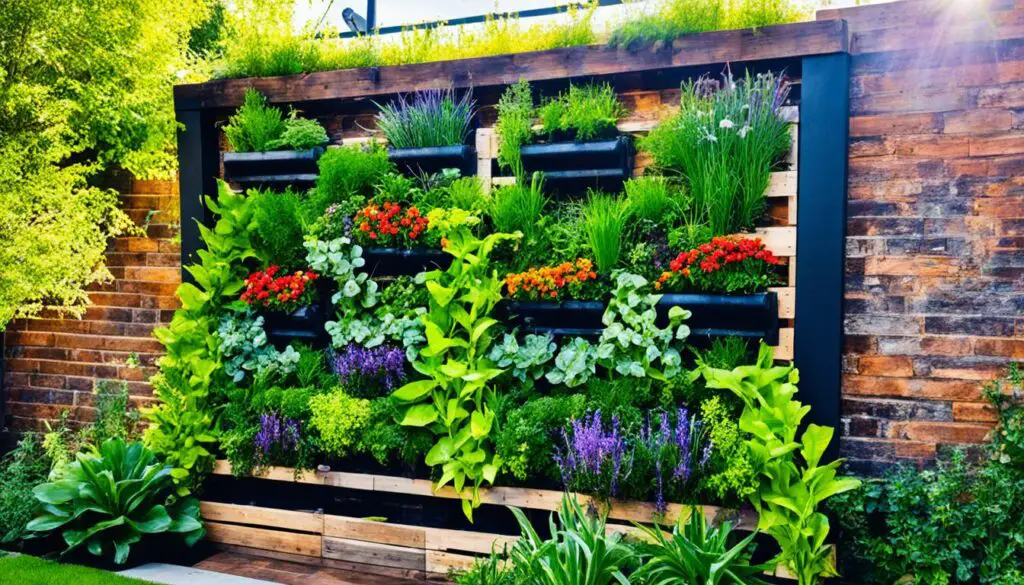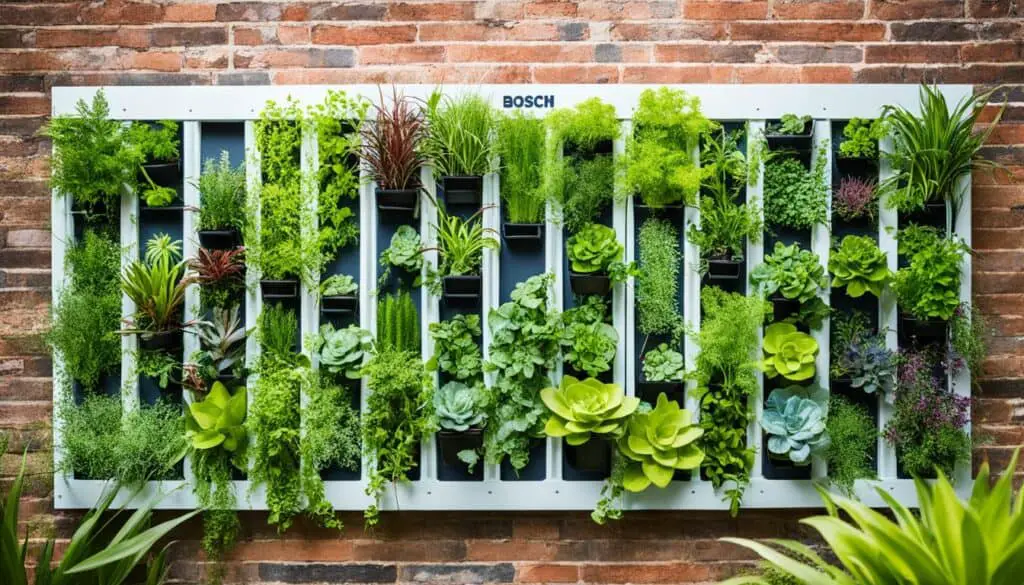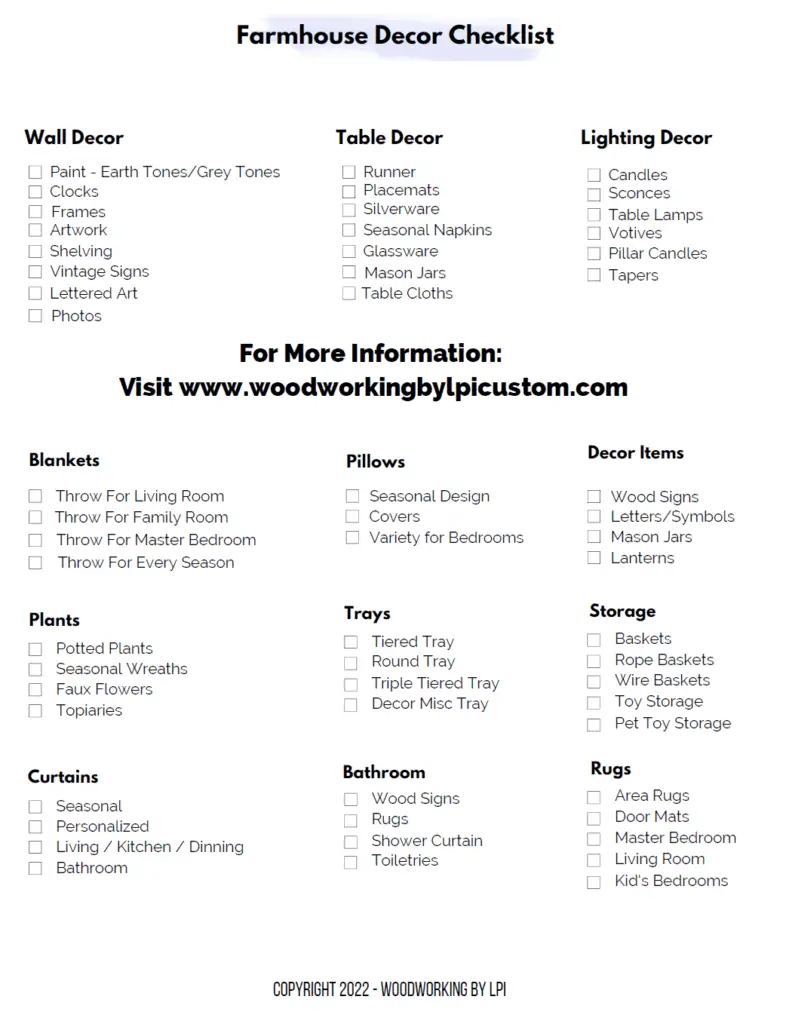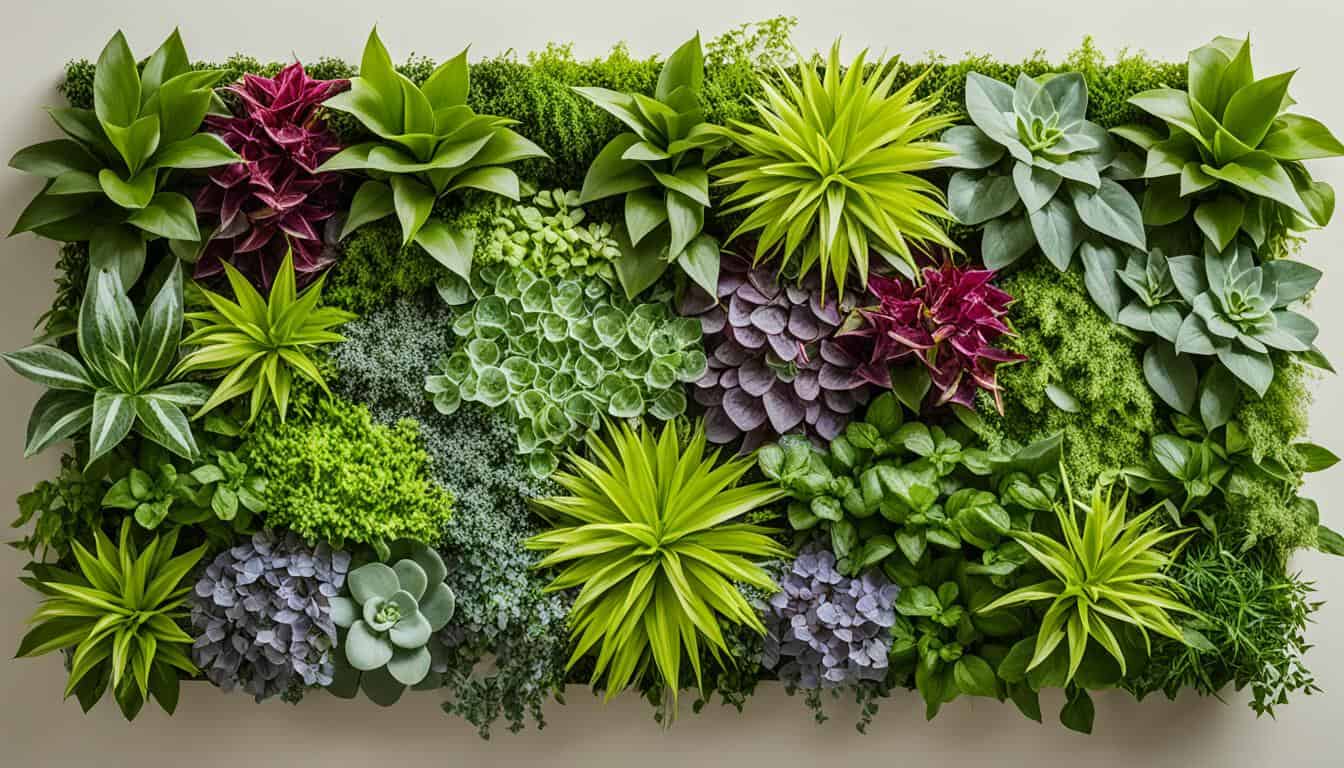Are you looking for a unique and space-saving way to enhance your outdoor space? Have you ever considered creating your own DIY vertical garden? Not only does vertical gardening offer a stunning aesthetic appeal, but it also provides a host of benefits for your plants and garden design. Discover the secrets of DIY vertical gardening and unlock the potential of your outdoor space.
The Benefits of Vertical Gardening
Vertical gardening offers a multitude of benefits for both garden enthusiasts and nature lovers. By leveraging vertical space, you can maximize your garden’s potential while enjoying a range of perks. Let’s explore the advantages of vertical gardening in detail.
Maximizing Garden Space
One of the key advantages of vertical gardening is the efficient use of space. Instead of spreading plants horizontally, vertical gardens allow you to grow plants vertically, utilizing walls, trellises, or structures. This vertical arrangement enables you to cultivate a wide variety of plants in a limited area, making it ideal for urban gardens or small outdoor spaces.
Easier Harvesting
With a vertical garden, harvesting becomes a breeze. Unlike traditional gardens where you have to bend down or kneel to pick crops, vertical gardens bring the harvest within easy reach. No more backaches or strained muscles! You can simply pluck fruits, vegetables, and herbs at an arm’s length, saving both time and effort.
Promoting Better Plant Health
Vertical gardening can have a positive impact on the health of your plants. By elevating them off the ground, you minimize the risk of soil-borne diseases, pests, and weeds. Additionally, better air circulation and sun exposure in vertical gardens help combat moisture-related issues, such as mold and mildew. This healthier environment often translates into more productive and vibrant plants.
Increased Productivity and Healthier Plants
Plants grown vertically tend to be more productive and healthier compared to their horizontally grown counterparts. The upward growth encourages better nutrient absorption, leading to optimal plant growth and yield. Vertical gardening is especially beneficial for vining plants like tomatoes, beans, cucumbers, and squash that thrive in a vertically oriented environment.
Enhanced Aesthetic Appeal
Vertical gardens not only offer practical advantages but also add a touch of beauty and visual interest to your outdoor space. The lush green foliage, cascading flowers, and vibrant colors create a stunning focal point that can transform an ordinary wall or structure into a breathtaking vertical oasis. Your backyard or balcony will become an enchanting haven that attracts attention and admiration.
Low Maintenance and Easy Upkeep
Maintaining a vertical garden is generally easier and less time-consuming compared to traditional gardens. Properly designed and installed vertical gardens have efficient irrigation systems that deliver water directly to the roots, reducing overall water consumption. Additionally, the vertical arrangement makes it easier to monitor and control pests, resulting in a lower need for pesticides. With proper planning and care, your vertical garden can thrive with minimal effort.
Ready to embrace the numerous benefits of vertical gardening and create your own stunning green space? Explore the next section to discover the most suitable plants for your vertical garden.
| Vertical Garden Benefits | Vertical Garden Plants | Vertical Garden Maintenance |
|---|---|---|
| Maximizes garden space | Tomatoes | Efficient irrigation systems |
| Easier harvesting | Beans | Reduced water consumption |
| Promotes better plant health | Cucumbers | Controlled pest management |
| Increased productivity and healthier plants | Squash | Minimal pesticide use |
| Enhanced aesthetic appeal | ||
| Low maintenance and easy upkeep |
Choosing the Right Plants for Your Vertical Garden
When it comes to vertical gardening, not all plants are suitable for growing in a vertical fashion. To ensure the success of your vertical garden, it’s important to choose the right plants that are well-suited to vertical growth. Here are some excellent options for vertical garden plants:
- Climbing beans: These legumes have long vines that are perfect for vertical growth. They add a touch of green and produce an abundant crop.
- Peas: With their delicate tendrils, peas are natural climbers and thrive when grown vertically. They offer vibrant blooms and delicious, sweet pods.
- Cucumbers: Cucumbers love to climb and can easily be trained to grow vertically. They produce crisp and refreshing fruits that are perfect for salads and pickling.
- Melons: These vine plants can be trained to grow vertically with the support of trellises or fences. Enjoy the sweet and juicy flavors of melons in your vertical garden.
- Squashes: Choose compact and bushy varieties of squashes for vertical gardening. They produce a bountiful harvest of delicious fruits and beautiful blooms.
- Tomatoes: Vertical gardening is an excellent way to grow tomatoes, especially determinate varieties. They ripen faster and are less prone to diseases when grown vertically.
When selecting plants for your vertical garden, consider choosing plants from the same family to create a cohesive and aesthetically pleasing look. This will give your vertical garden a harmonious and visually appealing design. Additionally, remember to group plants with similar water needs together in your vertical garden. This makes it easier to water and maintain your plants, ensuring each one receives the appropriate amount of water.
By carefully selecting the right plants for your vertical garden, you’ll create a thriving and beautiful garden that adds both greenery and functionality to your outdoor space.
“When selecting plants for your vertical garden, consider choosing plants from the same family to create a cohesive and aesthetically pleasing look.”
DIY Vertical Garden Ideas
If you’re looking to create a stunning vertical garden, there are endless options for you to explore. By using a variety of materials and innovative ideas, you can design a unique vertical garden that enhances your outdoor space. Let’s dive into some inspiring DIY ideas for your vertical garden.
Materials for Building Trellises and Frames
When it comes to constructing trellises and frames for your vertical garden, you have a wide range of materials to choose from. Consider using welded wire, T-posts, cattle panels, chicken wire, or even recycled fencing. These materials are sturdy and provide excellent support for your plants as they grow vertically. Get creative and mix and match different materials to create a visually appealing and unique structure for your garden.
Vertical Garden Containers
Vertical gardening doesn’t always have to involve building elaborate structures. You can also utilize various containers to showcase your plants in a vertical arrangement. Hanging baskets, pots, gutters, and repurposed items such as old buckets or crates can all be repurposed as vertical garden containers. Not only do these containers save space, but they also add a touch of charm to your garden.
Vertical Garden Walls
Another fantastic option for creating a vertical garden is utilizing your existing walls. Whether it’s a plain exterior wall or a bare fence, you can transform it into a beautiful vertical garden. Attach planter boxes or hanging baskets directly to the wall, or use a trellis system to support climbing plants. With some careful planning and creativity, you can turn any vertical surface into a thriving green display.
“Vertical gardening provides an excellent opportunity to utilize unconventional materials and repurpose items creatively.” – John Smith, DIY Gardening Enthusiast
Be resourceful and cost-effective while designing your vertical garden structure. Look around your home for materials that can be repurposed or visit local thrift stores for budget-friendly options. Remember, the key is to create a vertical garden that reflects your personal style and showcases your green thumb.
| Different Materials for Vertical Garden Structures | Advantages |
|---|---|
| Welded Wire | Durable and provides sturdy support |
| T-Posts | Easy to install and versatile |
| Cattle Panels | Strong and suitable for larger plants |
| Chicken Wire | Lightweight and flexible |
| Recycled Fencing | Eco-friendly and adds a rustic touch |
By utilizing these materials, you can build a vertical garden structure that meets your specific needs and complements your outdoor space.
Remember to consider the plants you want to grow and choose containers that provide adequate space for their growth. Additionally, ensure that your vertical garden receives sufficient sunlight and is easily accessible for watering and maintenance.
With these DIY vertical garden ideas, you can create a vibrant and visually stunning garden that maximizes your outdoor space. Bring your garden to new heights and enjoy the beauty and productivity of your DIY vertical garden.
Building Your DIY Arched Garden Trellises
Adding height and structure to your vertical garden is essential for creating an eye-catching design. One effective way to achieve this is by building arched garden trellises. These trellises not only provide support for your climbing plants but also add a beautiful architectural element to your garden.
To construct your arched trellises, you can use either cattle panels or welded wire. Both materials are affordable and readily available at garden supply stores. Choose the option that best suits your needs and budget.
To help you get started, here are some detailed step-by-step instructions:
- Measure and mark the desired width and height of your trellises using stakes and string.
- Dig holes at the marked spots to anchor the trellises securely into the ground.
- Place the cattle panels or welded wire between the holes, ensuring they are centered and level.
- Secure the panels to the stakes with zip ties or sturdy garden wire.
- Trim any excess material using wire cutters or pruning shears.
- Double-check the stability and adjust as needed.
- Your arched garden trellises are now ready to support your climbing plants and add visual interest to your vertical garden.
Remember to position your trellises strategically to maximize sunlight exposure for your plants. Consider the growth patterns and spacing requirements of your chosen climbing plants when determining the placement and number of trellises needed.
These arched trellises not only serve a functional purpose but also contribute to the overall aesthetic of your vertical garden. The gentle curves create a visually appealing contrast to the vertical lines of the plants, resulting in a more dynamic and captivating garden design.
Experiment with different vine and flower varieties to take full advantage of your new trellises. Watch as your plants climb and intertwine, transforming your vertical garden into a lush and vibrant sanctuary.
Vertical Gardening Tips and Tricks
To ensure the success of your vertical garden, it is important to follow certain tips and tricks. Consider factors such as plant spacing, watering requirements, and sunlight exposure to optimize the growth and productivity of your vertical garden.
Experiment with Plant Combinations and Arrangements
Vertical gardening offers a unique opportunity to get creative with plant combinations and arrangements. Mix different types of plants, including flowers, herbs, and vegetables, to add visual interest and maximize productivity. For example, planting trailing plants at the top and shorter plants at the bottom can create a cascading effect.
“The combination of bright-colored flowers and lush green foliage can create a stunning vertical garden that is both functional and beautiful.”
Monitor and Maintain Your Vertical Garden
Regular monitoring and maintenance are essential for a thriving vertical garden.
- Check plant spacing: Ensure that the spacing between plants is adequate to promote airflow and prevent overcrowding, which can lead to diseases.
- Watering requirements: Different plants have different water needs. Be mindful of the watering requirements of each plant and adjust accordingly.
- Sunlight exposure: Pay attention to the sunlight requirements of your plants. Some plants thrive in full sun, while others prefer partial shade. Position your vertical garden accordingly.
- Pruning and fertilizing: Regularly prune your plants to maintain their shape and encourage new growth. Apply organic fertilizers to provide essential nutrients for healthy plant growth.
Enjoy the Benefits of Vertical Gardening
Vertical gardening offers numerous benefits that make it a popular choice among gardeners.
| Vertical Garden Benefits | Description |
|---|---|
| Better space utilization | Vertical gardening allows you to make the most of limited outdoor space by utilizing vertical surfaces like walls and fences. |
| Easier harvesting | With a vertical garden, harvesting becomes more convenient as the plants are at eye level or within easy reach. |
| Improved plant health | Proper spacing, adequate airflow, and sunlight exposure in vertical gardens contribute to better plant health and disease prevention. |
| Aesthetic appeal | A well-designed vertical garden adds beauty and visual interest to your outdoor space, creating a unique focal point. |
Vertical gardening not only allows you to grow more in less space but also enhances the aesthetics of your garden.
By implementing these tips and tricks in your vertical garden, you can create a thriving and visually appealing space that showcases your gardening skills. Embrace the benefits of vertical gardening and enjoy the beauty and productivity of your DIY vertical garden.
Affordable DIY Vertical Garden Structures
If you don’t have an existing wall or fence, you can build your own vertical garden structure from scratch. Utilize scrap wood or repurposed materials to construct a vertical garden structure that suits your space and needs. Follow easy step-by-step instructions to create an affordable and customizable vertical garden.
Building a vertical garden structure doesn’t have to break the bank. With some creativity and resourcefulness, you can repurpose materials you already have or find affordable options to construct a unique vertical garden.
Utilize Scrap Wood
Do you have leftover planks from a previous renovation project or old wooden pallets lying in your garage? Don’t let them go to waste! Repurpose them into a DIY vertical garden structure.
“Scrap wood can make for excellent building material when it comes to constructing your vertical garden. Its rustic charm adds character to your garden while being environmentally friendly.”
To create the structure, cut the scrap wood into various lengths and sizes according to your design. Assemble the pieces using screws or nails to form a sturdy framework for your vertical garden. Be sure to sand down any rough edges to prevent splinters.
Repurposed Materials
Look around your home or visit a thrift store or local yard sales for repurposed materials that can serve as the foundation for your vertical garden structure. Get creative and explore unconventional options:
- Old ladders: Convert a ladder into a vertical garden by placing pots or hanging baskets on each step.
- Shoe organizers: Hang a shoe organizer on a sturdy wall or fence and fill each pocket with soil and plants.
- Used PVC pipes: Cut PVC pipes into different lengths and attach them to a wooden frame, creating a unique vertical structure for your plants.
Step-by-Step Instructions
To guide you in building your affordable DIY vertical garden structure, follow these simple steps:
- Choose a suitable location: Find an area with ample sunlight and enough space to accommodate your vertical garden.
- Gather materials: Collect the necessary tools such as a drill, screws, nails, and saw, as well as the chosen repurposed or scrap materials.
- Design and measure: Plan the design and measurements of your vertical garden structure. Consider the number of plants you want to grow and the space available.
- Cut and assemble: Cut the repurposed or scrap materials to the desired lengths and attach them using screws or nails. Ensure the structure is sturdy and secure.
- Secure to the ground or wall: Depending on the design, anchor the structure to the ground or attach it securely to a wall or fence.
- Add planters: Install your chosen planters, pots, or hanging baskets onto the structure, ensuring they are securely fastened.
- Plant and decorate: Fill the planters with fertile soil and carefully plant your chosen flowers, herbs, or vegetables. Add decorative elements, such as fairy lights or colorful signs, to personalize your vertical garden.
- Maintain and enjoy: Regularly water, prune, and maintain your vertical garden to promote healthy growth and vibrant foliage. Sit back and enjoy the beauty and benefits of your affordable DIY vertical garden.
By using affordable and easily accessible materials, you can create a unique and budget-friendly DIY vertical garden structure. Not only will you enhance the aesthetics of your outdoor space, but you’ll also enjoy the satisfaction of transforming ordinary items into a flourishing vertical garden.

Share Your Vertical Garden Projects
Are you proud of your DIY vertical garden creation? Share your innovative designs and inspire other gardening enthusiasts by showcasing your vertical garden projects. Join online forums and social media groups dedicated to vertical gardening to connect with like-minded individuals and exchange ideas, tips, and experiences.
By sharing your vertical garden projects, you can motivate others to explore the world of DIY vertical gardening and discover new possibilities in vertical garden design. Whether you have created a mesmerizing living wall or a space-saving vertical herb garden, your unique ideas can inspire creativity and innovation in the gardening community.
Use hashtags like #DIYVerticalGarden or #VerticalGardenDesign and tag relevant gardening accounts to reach a broader audience. Encourage others to share their projects and engage in conversations about vertical gardening techniques, plant choices, and maintenance tips.
The power of sharing your vertical garden projects extends beyond personal satisfaction. By showcasing your designs, you contribute to the collective knowledge and inspiration within the vertical gardening community, fostering a supportive environment for gardeners of all skill levels.
So, don’t hesitate to document and share your vertical garden journey. Whether you’re a beginner or an experienced gardener, your projects can inspire and ignite a passion for DIY vertical gardening in others.
Transforming Your Outdoor Space with DIY Vertical Garden
A DIY vertical garden has the power to transform your outdoor space into a lush and green oasis. Whether you have a small balcony or a spacious backyard, vertical gardening allows you to maximize your available space and unleash your creativity. By incorporating vertical gardening ideas into your outdoor design, you can create a stunning and functional vertical garden that adds beauty and vibrancy to your surroundings.
With an outdoor vertical garden, you can enjoy a variety of benefits. Not only does it enhance the aesthetic appeal of your space, but it also provides a sense of tranquility and freshness. By utilizing vertical gardening techniques, you can create a living work of art that showcases your favorite plants and herbs.
“A DIY vertical garden can turn even the most limited outdoor space into a thriving oasis of greenery and beauty.”
Vertical gardening ideas can be implemented in various ways, depending on your preferences and available resources. Create a vertical garden wall using trellises, hanging baskets, or repurposed materials. Utilize vertical garden containers like pots, gutters, or even repurposed items to add a touch of creativity. Combining different types of vertical garden structures can bring depth and texture to your outdoor space.
Enhancing Your Outdoor Vertical Garden with Plants
When choosing plants for your outdoor vertical garden, consider both aesthetic and practical factors. Select plants that thrive in your climate and suit the amount of sunlight your space receives. Herbs like basil, thyme, and rosemary are excellent options for a vertical garden. You can also include flowering plants, vines, and ornamental grasses to add color and variety.
Creating a vertical garden allows you to experiment with unique plant combinations. Consider selecting plants with contrasting foliage colors and textures for an eye-catching effect. Remember to choose plants that have similar water and maintenance requirements to ensure their health and vitality.
Designing the Perfect Outdoor Vertical Garden
Designing an outdoor vertical garden is a creative process that allows you to unleash your imagination. Consider the layout and size of your outdoor space, as well as your personal style preferences. Choose a color scheme, materials, and arrangements that complement your existing outdoor decor.
Integrating functional elements such as seating areas, pathways, or lighting can further enhance your outdoor vertical garden. By creating a harmonious blend of plants and design elements, you can transform your outdoor space into a picturesque sanctuary.
Remember to regularly maintain and care for your outdoor vertical garden. This includes watering, pruning, and providing adequate sunlight for your plants. With consistent attention and care, your vertical garden will continue to flourish and bring joy to your outdoor space.
| Benefits of an Outdoor Vertical Garden | Design Tips for Outdoor Vertical Gardens |
|---|---|
|
|
Building a DIY Vertical Planter Garden
Building a vertical planter garden is a satisfying and fulfilling DIY project that allows you to maximize your outdoor space. By utilizing some basic tools and materials, you can construct a multi-tiered planter system that is perfect for growing a variety of vegetables and greens. Follow these step-by-step instructions to build your own vertical planter garden and enjoy fresh produce right at your doorstep.
Gather the Materials
Before you begin, gather the following materials:
- Stair risers
- Planter boxes
- Screws
- Potting soil
- Vegetable and herb seeds or seedlings
- Watering can or hose
Constructing the Vertical Planter
Follow these steps to construct your vertical planter garden:
- Arrange the stair risers in a desired configuration. Be creative with the design and consider the available space.
- Attach the planter boxes to the stair risers using screws. Ensure that they are securely fastened to withstand the weight of the soil and plants.
- Fill each planter box with potting soil, leaving some space at the top for watering.
- Plant your chosen vegetable and herb seeds or seedlings in each planter box, following the recommended planting depth and spacing.
- Water the plants thoroughly using a watering can or hose, ensuring that the soil is evenly moist.
- Place your vertical planter in a sunny location, providing the plants with the necessary sunlight for healthy growth.
- Monitor the moisture levels in the soil and water as needed to keep the plants hydrated.
With your DIY vertical planter garden complete, sit back and watch your vegetables and greens thrive. Harvest fresh produce whenever it’s ready and enjoy the rewards of your hard work and creativity.
Transform your outdoor space into a lush and productive oasis with a DIY vertical planter garden.
Building a DIY Vertical Garden from Scrap Wood
If you have scrap wood lying around, you have the perfect opportunity to create a DIY vertical garden. With a few tools and some creativity, you can transform that unused wood into a stunning and functional vertical garden structure. Not only will you be repurposing materials, but you’ll also be adding a unique touch to your garden.
To begin, gather your scrap wood and assess its condition. Make sure it is free from rot, pests, and chemical treatments that could harm your plants. Once you have selected suitable pieces, measure and mark them according to your desired dimensions. A jigsaw will come in handy for cutting the wood into various lengths and shapes.
Once you have your cut pieces, it’s time to assemble them into the vertical garden structure. You can use nails, screws, or wood glue, depending on your preference and the durability you desire. Take your time to align the pieces properly and ensure that the structure is stable.
Adding shelves and planter boxes to your vertical garden is a great way to customize it and create more planting space. Use additional scrap wood to create these features, making sure they are securely attached to the main structure. The shelves can be used to display decorative items, while planter boxes provide the perfect spot for your favorite plants.
Remember to choose vertical garden containers that are appropriate for the types of plants you intend to grow. Options such as hanging pots, wall planters, or repurposed containers can work well in a DIY vertical garden. Consider the depth, drainage, and stability of the containers to ensure the health and growth of your plants.
Building a DIY vertical garden from scrap wood allows you to unleash your creativity and create a unique garden space. By repurposing materials and adding a personal touch, you can showcase your gardening skills and make a positive impact on the environment.
With your DIY vertical garden complete, step back and admire your creation. The combination of recycled wood and thriving plants is a testament to your resourcefulness and dedication to sustainable living. Share your project with others to inspire them to embark on their own DIY vertical garden adventure.
Building a DIY Vertical Garden with Bosch Home & Garden Tools
When it comes to constructing your DIY vertical garden, having the right tools is essential. That’s where the Bosch Home & Garden cordless tools come in. With their reliable performance and ergonomic design, these tools make the vertical garden installation process efficient and enjoyable. Here are the essential Bosch tools you’ll need:
Cordless Jigsaw
The cordless jigsaw from Bosch Home & Garden is perfect for cutting the wood pieces for your vertical garden structure. Its precision cutting ability allows you to create clean and accurate shapes, ensuring a sturdy and visually appealing design.
Cordless Drill
The cordless drill is indispensable for attaching the different elements of your vertical garden. Whether you’re securing panels, shelves, or pots, the Bosch cordless drill provides you with the power and control necessary for effortless installation.
Cordless Sander
After cutting and attaching the wood pieces, use the cordless sander to smooth the edges. This tool ensures a professional finish, making your vertical garden structure safe and comfortable to handle.
With these Bosch Home & Garden tools, you can embark on your DIY vertical garden project with confidence. Experience the convenience and versatility of these cordless tools as you bring your outdoor oasis to life.

| Benefits of Bosch Home & Garden Tools for Vertical Garden Installation |
|---|
| Reliable performance |
| Precision cutting and drilling |
| Ergonomic design for comfort |
| Efficient and enjoyable construction process |
Showcasing Your DIY Vertical Garden
Now that you have completed your DIY vertical garden, it’s time to showcase your masterpiece in your outdoor space. Take pride in your creation and create a visually stunning display that highlights the beauty of your vertical garden design.
Arrange your plants strategically, considering their colors, sizes, and growth patterns. This will create an aesthetically pleasing composition and maximize the impact of your vertical garden. Additionally, add decorative elements such as fairy lights, sculptures, or colorful planters to enhance the overall design.
“The true beauty of a vertical garden lies in the careful arrangement and thoughtful selection of plants. Let your creativity shine and create a living work of art.”
Don’t be afraid to share your DIY vertical garden with others. Take pictures and post them on social media platforms such as Instagram, Facebook, or Pinterest. Your creation may inspire others to embark on their own vertical gardening journey.
If you prefer a more personal touch, invite friends and family over to admire your outdoor vertical garden. Host a garden party or a casual get-together where you can showcase the beauty and productivity of your DIY vertical garden. Share your experiences, tips, and the joy of gardening with your loved ones.
Remember, your DIY vertical garden is a reflection of your creativity, dedication, and love for gardening. Take a moment to step back, admire your creation, and bask in the beauty and tranquility it brings to your outdoor space.
Enjoy the beauty and productivity of your DIY vertical garden, and let it be a source of inspiration for your future gardening endeavors.
Conclusion
Creating a DIY vertical garden is a rewarding and fulfilling experience. It allows you to maximize your outdoor space and transform it into a thriving green oasis. By utilizing innovative ideas and affordable materials, you can design a vertical garden that suits your style and needs.
Vertical gardening offers numerous benefits, including easier harvesting, improved plant health, and enhanced garden design. It allows you to grow a wide variety of fruits, vegetables, and herbs in a limited space, making it ideal for urban dwellers or those with small gardens.
Embrace the beauty and productivity of your DIY vertical garden. Experiment with different plant combinations, arrange them creatively, and create a stunning focal point in your outdoor space. Whether you have a small balcony, patio, or backyard, vertical gardening ideas can be customized to suit your available area.
So, why wait? Dive into the world of DIY vertical gardening and enjoy the satisfaction of nurturing a beautiful and productive garden right at your doorstep. Start your own DIY vertical garden project today and reap the rewards for years to come!
FAQ
What is vertical gardening?
Vertical gardening is a technique that involves growing plants vertically, either against a wall or in containers. It is a space-saving and efficient way to expand your garden.
What are the benefits of vertical gardening?
Vertical gardening offers several benefits, including maximizing garden space, easier harvesting, improved plant health, and enhanced garden design.
Which plants are suitable for vertical gardening?
Climbing beans, peas, cucumbers, melons, squashes, and tomatoes are some of the best options for vertical growth. Choose plants from the same family for an aesthetically pleasing look.
What are some DIY ideas for creating a vertical garden?
You can use materials like welded wire, T-posts, cattle panels, chicken wire, and recycled fencing to build trellises and frames for your plants. Hanging baskets, pots, gutters, and repurposed items can also be utilized.
How can I build arched garden trellises for my vertical garden?
You can use cattle panels or welded wire to construct arched trellises. Follow detailed step-by-step instructions to build sturdy and affordable trellises that can support your climbing plants.
What are some vertical gardening tips and tricks?
Consider factors like plant spacing, watering requirements, and sunlight exposure. Use vertical gardening as an opportunity to experiment with different plant combinations and arrangements. Regularly monitor and maintain your vertical garden for optimal plant health.
How can I create an affordable DIY vertical garden structure?
If you don’t have an existing wall or fence, you can build your own vertical garden structure from scratch using scrap wood or repurposed materials. Follow easy step-by-step instructions to create an affordable and customizable vertical garden.
How can I share my vertical garden projects?
Share your vertical garden projects with others to inspire and motivate fellow gardening enthusiasts. Join online forums or social media groups dedicated to vertical gardening to exchange ideas, tips, and experiences.
How can I transform my outdoor space with a DIY vertical garden?
A DIY vertical garden can transform your outdoor space into a lush and green oasis. Whether you have a small balcony or a spacious backyard, vertical gardening allows you to make the most of your available space.
How can I build a DIY vertical planter garden?
With some basic tools and materials, you can construct a multi-tiered planter system using stair risers, planter boxes, and screws.
How can I build a DIY vertical garden with scrap wood?
Use a jigsaw to cut the wood into various lengths and shapes, and assemble them to form a vertical garden structure. Add shelves and planter boxes to customize your vertical garden according to your preferences.
How can Bosch Home & Garden tools help in building a DIY vertical garden?
The Bosch Home & Garden cordless tools, like the cordless jigsaw, cordless drill, and cordless sander, are perfect for building a DIY vertical garden. They make the construction process efficient and enjoyable.
How can I showcase my DIY vertical garden?
Arrange the plants and add decorative elements to enhance the overall design. Share your vertical garden on social media or invite friends and family to admire your creation.
What is the importance of a vertical garden?
Vertical gardening is an affordable and space-saving way to expand your home garden. It offers numerous benefits, including easier harvesting, improved plant health, and enhanced garden design.












